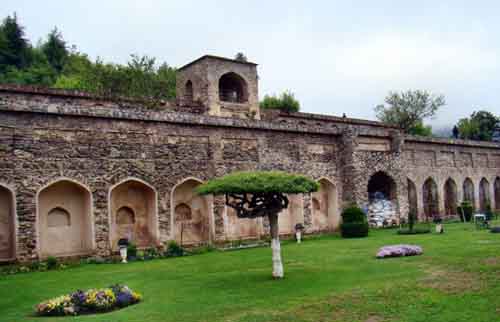Pari Mahal Srinagar

Information on Pari Mahal (Srinagar, Jammu and Kashmir) - History & Architecture
Pari Mahal which actually means 'The Fairies Abode' is situated at the pinnacle of the Zabarwan range of mountain which commands a view of the Srinagar city and also the south western side of the popular Dal Lake. The place is supposed to be just a drive of five minutes from Cheshmashahi in Srinagar. The Pari Mahal is an astonishing structure and appears fascinating at night owing to the radiant lights which makes it visible from almost all the places in Srinagar city. Pari Mahal was actually a Buddhist monastery once upon a time which was later transformed into an astrology school by Dara Shikoh.
Pari Mahal Architecture
Pari Mahal is a popular historic structure in Kashmir and is located on top of the attractive Chashma Shahi Gardens close to Srinagar. It is a terraced garden which includes seven layers and the design as well as the architectural pattern stands testimony to the fact relating to superior quality of Islamic style of architecture and patronage of fine work at the time of the reign of the eminent Mughal Emperor, Shah Jahan. A neatly spread manicured and open garden is known to encircle the monument. The Pari Mahal is supposedly dissimilar from the other gardens in Kashmir as it does not hold any kind of water chutes or cascades. However, the possibility of fountains in the reservoirs cannot be completely ruled out with regard to Pari Mahal. The supply of water was chiefly carried out with the aid of underground pipes made of clay, nevertheless a few evidences related to open water lines were also found. The garden mainly comprises six balconies and has the total measurement lengthwise is about 400 feet. The breadth of the different verandas differs from 179 feet to 205 feet. The topmost terrace consist of the wrecks of two formations among which one is a Barahdari or palace which faces the famous Dal lake and the second one is of a water tank which was constructed alongside the mountain. The tank was believed to get its water supply from a spring located above which has gone dry since long and the existing remnants are the broken stone waterway and the supporting wall alongside the hill. Pari Mahal is a plain chamber made of rubble lime stones with a concealment of two small size arches.
Pari Mahal History
Pari Mahal was formerly a garden which was established by Dara Shiko during the mid period of 1600 on the wrecks of a Buddhist monastery. Dara Shiko was the eldest son of the famous Mughal Emperor Shah Jehan and built the garden in the honour of his Sufi teacher named Mulla Shah. The garden in the past used to be scattered with several springs which are found to have dried up in the recent years. The gardens of the Pari Mahal are presently considered to be the prized property of the particular state. Prince Dara was believed to display ardent interest in the fields of Sufism as well as Astronomy and therefore, the Pari Mahal was used as an observatory. The ancient structure represents the architectural brilliancy that prevailed during the medieval period. The Pari Mahal was actually planned to serve as a place of relaxation for the Sufi researchers.
Pari Mahal Tourism Importance
Pari Mahal is considered to be an imperative historical monument coupled with well maintained spacious garden. This feature of the Pari Mahal is known to attract tourists greatly from across the globe.
- Andaman Nicobar Monuments
- Andhra Pradesh Monuments
- Assam Monuments
- Bihar Monuments
- Chhattisgarh Monuments
- New Delhi Monuments
- Goa Monuments
- Gujarat Monuments
- Haryana Monuments
- Himachal Pradesh Monuments
- Jammu and Kashmir Monuments
- Karnataka Monuments
- Kerala Monuments
- Madhya Pradesh Monuments
- Maharashtra Monuments
- Odisha Monuments
- Punjab Monuments
- Rajasthan Monuments
- Tamil Nadu Monuments
- Telangana Monuments
- Uttar Pradesh Monuments
- West Bengal Monuments